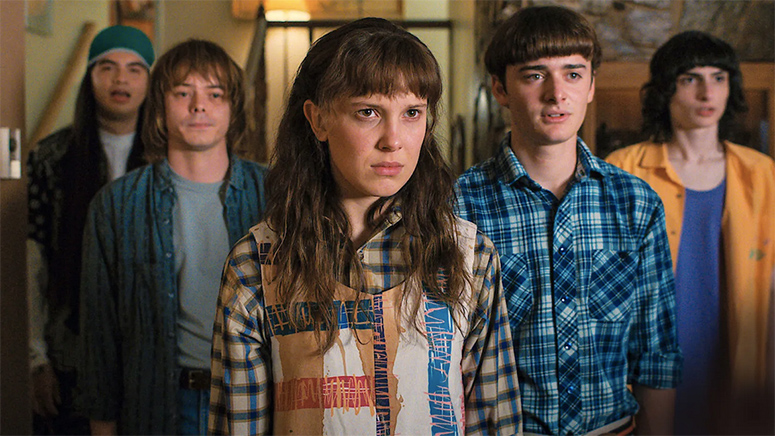80’s vibes
For some, the ’80s never really went away. Comebacks from that era are prevalent everywhere, whether it’s popular culture, music, or even… politics.
Both Marvel’s Thor: Love and Thunder and the Netflix series Stranger Things traffic in that distinct ’80s vibe: you can see it in the Stephen King paperback fonts that announce Stranger Things, and in the retro heavy metal closing titles of Taiki Waititi’s latest superhero installment.
After steering Thor into decidedly funnier waters with Thor: Ragnarok, it was a no-brainer that Love and Thunder would just keep on doing more of the same: Thor (Chris Hemsworth) parodying his own self-importance, with a cast of Waititi comical figures populating a landscape that owes as much to Dungeons & Dragons and the neon of arcade games as it does the rainbow-and-candy-colored hues of ‘80s cartoon My Little Pony.

Waititi opens with Christian Bale crawling across a dying desert planet (shades of Mad Max movies), and quickly dials up ’80s sound pegs: Enya and Guns ‘n’ Roses (a lot of Guns ‘n’ Roses) to accompany the transformation of Thor from “dad-bod” to “god-bod.” But he now has company: Dr. Jane Foster (Natalie Portman) is back, and she’s somehow in charge of Mjolnir, Thor’s hammer. (This leads to some of Love and Thunder’s funniest bits: Thor, trying to woo back Mjolnir, earns shade and dirty looks from Stormbreaker, his trusted old axe.) There’s also the outing of at least two LGBTQ characters, so maybe the rainbow hues are there for a reason.
Muscles are also a recurring theme — not just Hemsworth’s newly chiseled upper body, but Portman’s pro wrestler look, summoning up ’80s memories not only of WWF stars, but monster truck rallies and American Gladiators.
Then there’s the whole “Satanist” scare that swept through America in the ’80s, causing the Christian Right to slap warning labels on records and demonize heavy metal bands like Judas Priest.
Russell Crowe is on hand (and on ham) as Zeus, sporting a Russian mobster accent that plays like commentary on the current Ukraine situation. Bale throws his all into playing a mournful character (Gorr the God Butcher) turned evil, hell-bent on killing off all the gods as a form of revenge. An attempt to graft more serious dimensions onto the story, though, introduces tonal shifts that sometimes feel forced. When your tone is firmly in Kitsch Land, you can’t expect us to get too emotionally invested. And while there’s lots to gawk at in Love and Thunder, thanks to Waititi’s wacky pop-art visuals, there isn’t that much story, really; it’s all boom-boom and not much real impact. Kind of like the self-consciously over-the-top fonts that roar across the closing credits.

The Duffer Brothers, creators of Stranger Things, have never made a secret of their ’80s influences. In Season 4, the series does its usual thing: taking its time to reintroduce characters (it has been a few years between seasons; thanks a lot, COVID), almost daring us not to care or engage too much — then ratcheting things up and knocking it out of the ballpark as the season moves toward its conclusion.
As we pick up on the kids of Hawkins, Indiana, they’re separated by college and life and all the bad events that happened in Season 3. (You’re on your own; Google it.)
El (Millie Bobbie Brown) is rendered mostly powerless after her last battle with the Upside Down. This time around, there’s a more physical manifestation in the form of Vecna, an evil demon who has a habit of luring kids in through their favorite songs, then raising them up in the air and twisting their limbs around in very unnatural poses. Twisted Sister, indeed.
The ‘80s references are all over the place, from the obvious and most persistent (Kate Bush’s Running Up That Hill persistently running on the soundtrack), to flashes of bloody corpses in hallways (shades of The Shining) to subtle things, like the Red Dawn Russian vibe where Hopper (David Harbour) is kept prisoner, the little references to War Games or Freddie Kreuger or Altered States (El in the sensory deprivation tank), even the Classic Coke prominent in one scene and the Tom Cruise poster in Nancy’s bedroom. Then there’s the whole “Satanist” scare that swept through America in the ’80s, causing the Christian Right to slap warning labels on records and demonize heavy metal bands like Judas Priest. There are random Molly Ringwald doppelgänger sightings, and Eddie wearing a Mike Myers mask from Halloween, and Demogorgons reminiscent of the Xenomorphs from Alien, until even Murray’s karate chops start to resemble Miss Piggy in The Muppet Show. It’s all in there, like some bottomless ’80s Easter Egg hunt.
The Duffer Brothers do take their time in warming up the story, and this season is broken into two unequal parts — the final three episodes dropping weeks after the first six, a kind of new strategy for Netflix. But it grows on you, the way each season does, as the one-liners reach a level of nostalgic youth memory: we’ve all had friends whose chops we liked to bust, just like these kids do. By the end of this saga, which finds Joyce (Winona Ryder) on a mission to rescue Hopper from somewhere in the frozen tundra, and El escaping from the grip of the Nina Project under evil “Papa” Martin Brenner (Matthew Modine), we’re with this ragtag team once again: they pull us into the fun, and we can forgive the lengthier episodes for all the insider ’80s references packed into each outing.


